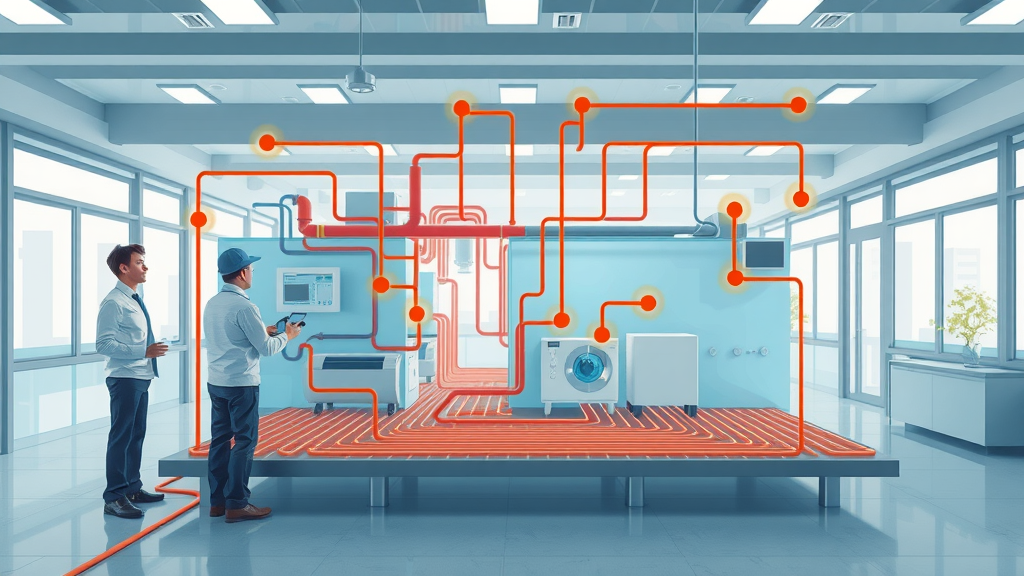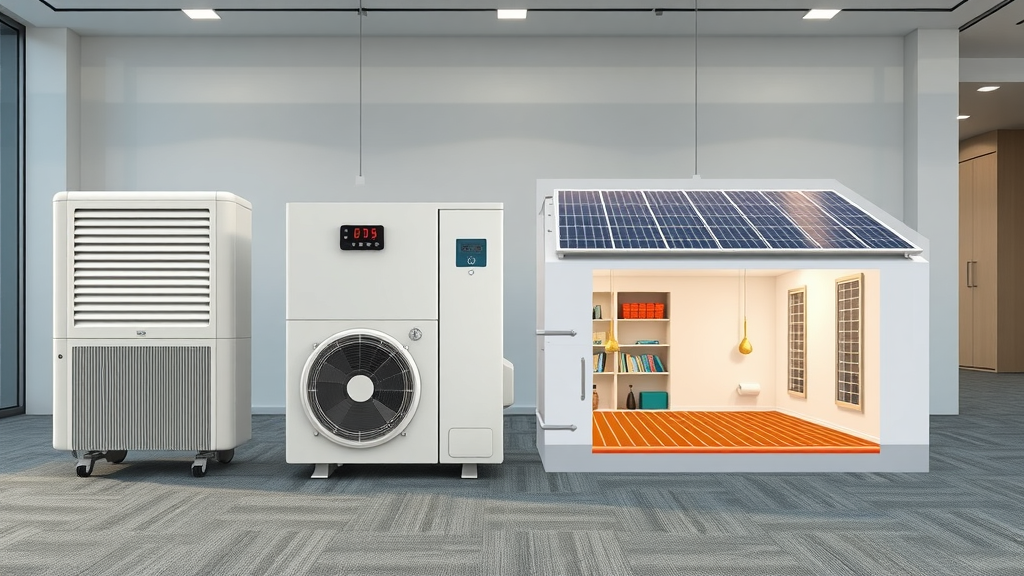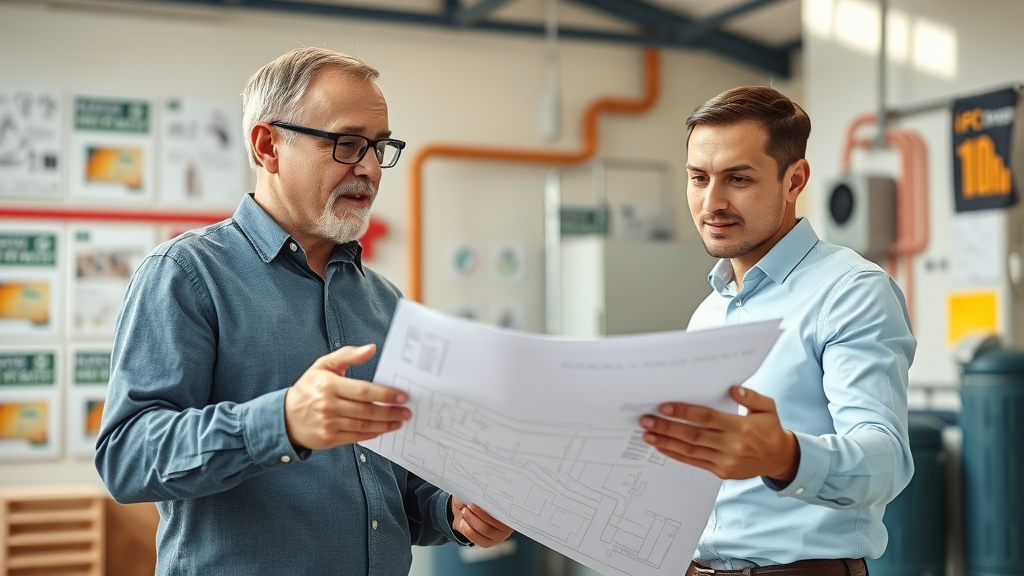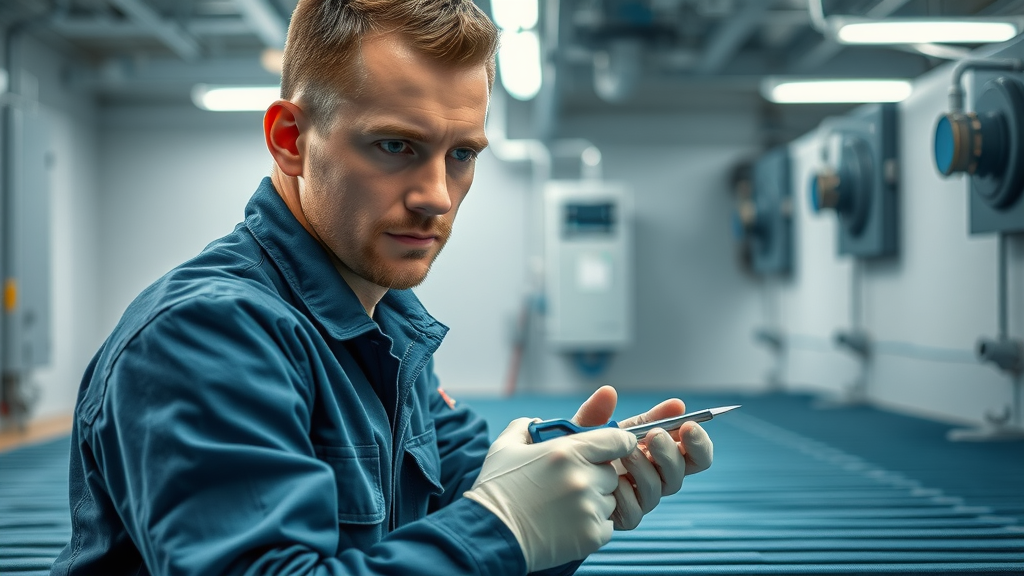Did you know that UK commercial properties spend more than half of their energy costs on heating alone? With a figure that high, finding the right energy efficient heating solutions is more than smart—it’s urgent. In this guide, you’ll discover how to slash your heating bills fast while creating a comfortable, future-ready building that impresses clients and keeps occupants productive.
Startling Statistics: Why Energy Efficient Heating Solutions Matter
"On average, UK commercial properties spend over 50% of their energy costs on heating – making energy efficient heating solutions an urgent priority for long-term savings."

The scale of heating costs in commercial spaces is staggering. Between overheads, compliance with gas safe standards, and the constant pressure of rising energy prices, many businesses feel the pinch—especially during the colder months. Transitioning to energy efficient heating solutions is the surest way to achieve rapid savings and manage your property’s carbon footprint. By upgrading old heating systems or transitioning to modern alternatives, you can transform your utility spending, ensure regulatory compliance, and even enhance property value.
These savings don’t just make the finance department happy—they also reflect positively on your company’s reputation and environmental commitments. Now, let’s look at what you will learn to make the most of these game-changing advancements.
What You'll Learn in This Guide to Energy Efficient Heating Solutions
- The main types of energy efficient heating solutions for commercial properties
- How electric heat, heat pumps, and efficient heating systems lower operating costs
- Key factors affecting your choice of heating systems
- How underfloor heating outperforms traditional heating solutions
- Impact of energy efficient heating on carbon footprint and energy bills
With these practical insights, you’ll be well-positioned to choose the most effective heating system—boosting savings, improving sustainability, and keeping your property comfortable all year round.
Understanding Energy Efficient Heating Solutions and Heating Systems
What Makes a Heating System Energy Efficient?
An energy efficient heating system is designed to convert the highest possible proportion of input energy (electricity, gas, or renewables) into usable heat with minimal losses. Unlike older heating solutions like traditional gas boilers, efficient alternatives use innovative technology—like heat pumps, advanced underfloor heating, or electric heating controls—to circulate heat precisely when and where you need it. These systems often work at lower temperatures while still providing the comfort levels required in commercial spaces, thanks to smarter designs and the integration of smart thermostats.
Factors such as insulated pipework, occupancy-based scheduling, and the ability to heat only targeted zones make a huge difference. By focusing on performance metrics such as Seasonal Coefficient of Performance (SCOP) and integrating advanced heating controls, today’s solutions offer not just comfort but longevity and low maintenance. Businesses are finding that these improvements quickly translate into lower energy bills and significant carbon savings, making efficient heating upgrades a wise investment.
For those looking to implement practical steps right away, exploring a range of energy efficient heating tips for instant savings can help you identify quick wins and everyday adjustments that complement larger system upgrades.
Key Factors Affecting Efficient Heating Performance
The true efficiency of a modern heating system depends on several factors. The type and layout of your building, quality of insulation, and the specific technology all play a part. For example, properties with high ceilings or lots of glass may lose heat faster and benefit distinctly from underfloor heating or properly sized heat pumps. Meanwhile, adding smart zoning controls allows heating to adapt in real time based on usage—crucial for busy offices, retail parks, or multi-tenanted spaces.
Don’t underestimate the impact of regular servicing and following gas safe protocols for gas-powered systems. Attention to detail—like correct sizing of the system, quality installation, and ongoing maintenance—ensures you get the full advantages of energy efficiency, cost control, and safe operation for many years.

Comparing Types of Energy Efficient Heating Solutions
Electric Heating vs Gas Boiler: Which Is Right for You?
Deciding between electric heating and a gas boiler is a major decision for any commercial property. Gas boilers have long been standard, valued for rapid warmth and familiarity with gas safe compliance. Yet, electric heating has made serious strides—especially with the rise of efficient electric radiators, fan-assisted heaters, and advanced underfloor systems powered by electricity.
Electric systems are often easier to install, require less maintenance, and future-proof your facility against expected gas phase-outs. If sustainability and flexible control are at the top of your priorities, electric heat options—paired with smart controls—may offer considerable ongoing savings and reduced carbon emissions. However, initial running costs can be higher if tariffs are not optimised or if insulation is lacking, so weigh these factors alongside your property’s specific needs.
Heat Pumps: Air Source and Ground Source Explained
Heat pumps are changing the landscape of efficient heating—with air source heat pumps and ground source heat pumps leading the charge. Air source heat pumps transfer warmth from outside air into your building, delivering up to four times more energy than they consume. Ground source heat pumps, meanwhile, harness stable underground temperatures for even greater efficiency and year-round reliability.
These systems can provide hot water and central heating, operate at low carbon levels, and often qualify for government incentives. Initial installation costs may be higher, but ongoing savings on your energy bills and carbon footprint are significant. For businesses focused on energy saving trust, heat pumps can be a compelling component of a hybrid or standalone heating solution, often paired effectively with underfloor systems for unbeatable comfort and savings.
Solar Panels and Low Carbon Heating Solutions
Incorporating solar panels is one of the smartest ways to achieve a low carbon profile for your heating system. While solar panels alone may not provide all the heat your property requires, they contribute significant input to electric heating systems, direct hot water tanks, or even to power heat pumps. The result is lower reliance on fossil fuels, ongoing reductions in your energy bill, and a step-forward in environmental stewardship that clients, investors, and staff increasingly value.
Integrating solar panels with advanced controls also maximises self-consumption, letting you bank excess power or qualify for export payment schemes. The combined effect is a heating solution that’s as friendly to your operating budget as it is to the environment.
Underfloor Heating Systems: The Ultimate Efficient Heating System
For many commercial properties, underfloor heating is the gold standard in energy efficiency. Unlike radiators or air-blown systems, underfloor setups distribute warmth evenly across the entire surface, reducing wasted heat and eliminating chilly spots. These systems operate at lower water temperatures—making them ideal partners for heat pumps and renewable energy—while delivering superior comfort.
With no bulky units on walls and precise, zone-level control, underfloor heating leaves more usable floor space and is perfect for large open-plan areas like showrooms, offices, or retail parks. As an efficient heating system, it’s not just about comfort: you’ll see real, immediate savings on your energy bills and establish a sustainable, future-proof heating approach.
| System Type | Efficiency | Carbon Footprint | Installation Costs | Running Costs | Suitability |
|---|---|---|---|---|---|
| Electric Heating | 80–99% | Depends on electricity source | Low–Medium | Medium–High | Small to medium sites, quick retrofits |
| Gas Boilers | 70–90% | High (fossil fuel-based) | Low–Medium | High | Older properties, legacy systems |
| Heat Pumps | 250–400% | Very Low | Medium–High | Very Low | All sizes, best with insulation |
| Solar Panels | Varies (supports others) | Zero | Medium–High | Negligible | Any, needs roof/ground area |
| Underfloor Heating | Up to 98% (with low-temp source) | Very Low (heat pump/solar) | Medium | Very Low | Large open-plan, new builds/renovations |

How Underfloor Heating Delivers Unmatched Energy Efficiency
Why Underfloor Heating is Ideal for Commercial Properties
Underfloor heating offers a host of advantages for commercial properties—large or small. These systems are hidden beneath the floor, freeing up walls for retail displays, furnishings, or open workspace designs. They provide steady, radiant warmth at low water temperatures, maximising the output of efficient heat pumps and minimising waste compared to traditional systems. As a result, buildings stay comfortable, occupants are more productive, and property managers see substantial cuts in heating and maintenance costs.
For expansive commercial interiors, underfloor heating eliminates cold spots and delivers silent operation—keeping team meetings, client encounters, and day-to-day business running smoothly. The precision of zone-based control allows for enormous energy savings too: only heat what you need, when you need it. For any modern business or property owner looking to upgrade, underfloor heating is the benchmark for both performance and efficiency.
Pairing Underfloor Heating with Efficient Heating Controls
Adding smart heating controls supercharges the efficiency of underfloor systems. By scheduling warmth around office hours, monitoring temperatures remotely, and adapting to seasonal changes, these controls keep comfort high and costs low. Many systems now offer integration with building management systems (BMS), mobile controls, and detailed usage reporting—giving you comprehensive oversight and the ability to fine-tune your savings.
Advanced controls also play a vital role in maintaining gas safe standards and compliance with building regulations for mixed or legacy systems. When properly configured, they allow commercial properties to benefit from the full spectrum of energy saving trust recommendations while delivering consistent warmth and air quality.
"Switching to underfloor heating with modern controls can decrease heating bills by up to 25% for commercial sites."
Calculating Savings: How Energy Efficient Heating Solutions Cut Your Energy Bills
The Relationship Between Heating System Upgrades and Energy Bills
Upgrading to an efficient heating system can dramatically transform your business’s bottom line. Old systems, especially aging gas boilers and single-zone radiators, are less effective, more costly to repair, and above all, waste energy. Modern heat pumps, underfloor heating, and electric systems—when combined with smart controls—have been shown to reduce energy bills by 20–30% immediately after installation.
The savings go beyond heating costs: better control means reduced wear and tear on components, lower maintenance bills, and less downtime. Plus, with government incentives for low carbon upgrades, the transition to new heating solutions has never been more cost-effective.
Estimating Payback and ROI on Efficient Heating System Investments
How quickly will you recoup your investment? For most commercial properties, the payback period on an efficient heating system typically ranges from 2 to 6 years—shortened further when you include grants, reduced maintenance, and increased property value. Calculating ROI means factoring in reduced energy consumption, lower carbon emissions, and less downtime thanks to modern heating controls.
The transition also shields your property from energy price volatility, elevates your reputation, and illustrates a genuine commitment to sustainability. When underfloor heating is partnered with heat pumps or solar, the savings multiply—making it clear why so many UK commercial sites are making the switch.
- Reduced energy bills with efficient systems
- Lower maintenance costs
- Decreased carbon footprint
| System | Upfront Cost | Annual Running Cost | Average Annual Savings | Payback Period | Carbon Emissions |
|---|---|---|---|---|---|
| Legacy Gas Boiler | £5,000 | £12,000 | n/a | n/a | High |
| Modern Underfloor + Heat Pump | £18,000 | £7,000 | £5,000+ | 3–4 years | Very Low |
| Electric Heating (Smart Control) | £7,000 | £9,500 | £2,500+ | 3 years | Depends on grid |
Case Study: Dramatic Savings Achieved Through Efficient Heating System Conversion

"After installing a new energy efficient heating system, we saw immediate savings of 30% on our winter heating bills." – Facilities Manager, UK Retail Park
In a UK retail park, the facilities manager faced steep winter heating bills due to outdated, inefficient gas boilers. After consulting with Peak Underfloor Heating Ltd, the property was upgraded to a hybrid system combining underfloor heating, an air source heat pump, and smart controls. The result? Not only did the property achieve a 30% cut in heating bills in the first year, but it also reported improved comfort for staff and shoppers, greater reliability, and easier compliance with energy regulations.
These dramatic—and replicable—savings show the real-world impact of switching to the latest energy efficient heating solutions.
Factors to Consider When Choosing the Right Heating Solutions for Your Property
- Property size and usage schedule
- Existing heating system and infrastructure
- Budget and long-term operational costs
- Building regulations and gas safe requirements
- Potential carbon footprint reductions
A successful transition begins with a close examination of your current setup and future ambitions. Whether you’re upgrading a single unit or planning a large commercial retrofit, consider energy efficiency, compliance, and sustainability alongside your financial goals. Working with experienced consultants like Peak Underfloor Heating Ltd ensures every factor is addressed—guaranteeing performance, safety, and value for years to come.
Expert Advice: Consulting on Efficient Heating for Your Next Project
"Investing in tailored heating solutions ensures maximum energy efficiency and future-proofs your commercial property."

Every property is unique—and so are its heating needs. Our consultants at Peak Underfloor Heating Ltd take pride in delivering bespoke, energy efficient heating solutions for offices, retail parks, warehouses, and more. We consider building size, usage profiles, regulations, and the latest innovations to design systems that maximise comfort while reducing energy bills and carbon footprint. If you’re planning a new build or major renovation, early-stage advice can save thousands over the lifetime of your property.
With heat pumps, underfloor heating, solar panels, and advanced control systems in our toolkit, you can be confident your investment will keep delivering for decades. Don’t settle for off-the-shelf solutions—work with experts who know the science, regulations, and technology inside out.
People Also Ask: Energy Efficient Heating Solutions
What is the most energy-efficient way to use heating?
The most energy-efficient way to use heating is to combine an efficient heating system—like underfloor heating or a heat pump—with smart heating controls and adequate insulation, ensuring you heat only the spaces you use to the necessary temperature.
What is the most energy-efficient heating system?
Currently, air source and ground source heat pumps, as well as modern underfloor heating systems, are recognised as the most energy-efficient heating systems due to their low running costs and reduced carbon emissions.
What is the most efficient heating system with electricity?
Modern electric heat pumps paired with underfloor heating, and smart electric heating controls, maximise efficiency for electrically powered systems.
What's the cheapest way to have your heating on?
The cheapest way is to use an efficient heating system, maintain regular servicing (gas safe where applicable), utilise smart controls, and ensure excellent insulation—this combination cuts costs while retaining comfort.
FAQs: Energy Efficient Heating Solutions
- What maintenance is required for modern heating systems? Modern systems require periodic inspections, cleaning, and calibration. For gas systems, always use gas safe registered engineers.
- Are government grants available for upgrading to efficient heating solutions? Yes, several grants and incentives are available for upgrading to energy efficient systems, particularly those using low carbon technologies.
- Can efficient heating systems be retrofitted to older properties? Absolutely. Most efficient heating solutions can be retrofitted, though it’s important to assess insulation and structural layout first.
- What are the typical installation times for underfloor heating? Depending on project size and specification, installations can range from a few days to a couple of weeks for large commercial properties.
- Are all systems gas safe and compliant with UK regulations? All systems installed must comply with UK gas safe regulations and building codes to ensure safety and performance.

Key Takeaways: Why Choose Energy Efficient Heating Solutions
- Immediate and long-term cost savings
- Lower carbon emissions and improved sustainability
- Enhanced comfort and productivity for commercial spaces
- Future-proofing against energy price volatility
Conclusion: Achieve Efficient Heating – Unlock Savings with Peak Underfloor Heating Ltd
"Choosing energy efficient heating solutions is an investment in your property’s future, profitability, and environmental responsibility."
Taking action now guarantees lower energy bills, happier occupants, and a property that’s ready for whatever the future brings.
If you’re eager to deepen your understanding and take your energy savings even further, consider exploring broader strategies that go beyond system upgrades. By learning about holistic approaches and expert-backed advice, you can unlock even more value from your heating investments. For a comprehensive look at actionable methods and advanced tips, visit our guide on energy efficient heating tips for instant savings. This resource is packed with practical ideas to help you maximise efficiency, reduce costs, and future-proof your property for years to come.
Contact Us for Tailored, Energy Efficient Heating Solutions
It can be difficult to know exactly what system is best for your application so if you are still unsure please feel free to contact us and one of our consultants will be happy to discuss your exact requirements. Call 01246 387120, or Email us at info@peakunderfloorheating.com
Sources
- Energy Saving Trust – https://www.energysavingtrust.org.uk/advice/heating-and-hot-water/
- UK Government: Improve Energy Efficiency – https://www.gov.uk/improve-energy-efficiency
- Carbon Trust: Energy Efficient Heating Guide – https://www.carbontrust.com/resources/energy-efficient-heating-guide/
To further enhance your understanding of energy-efficient heating solutions, consider exploring the following resources:
-
“Top 7 Energy-Efficient Heating Options for Every Home”: This article provides a comprehensive overview of various heating systems, including heat pumps, radiant floor heating, and high-efficiency furnaces, detailing their benefits and suitability for different home types. (mooresac.com)
-
“Top 5 Energy Efficient Heating Solutions for 2025”: This resource outlines the latest advancements in heating technology, such as air source heat pumps and hybrid heating systems, offering insights into their efficiency and potential cost savings. (fischerfutureheat.com)
If you’re serious about reducing your heating bills and enhancing your property’s energy efficiency, these resources will provide valuable information to guide your decisions.
 Add Row
Add Row  Add
Add 









Write A Comment